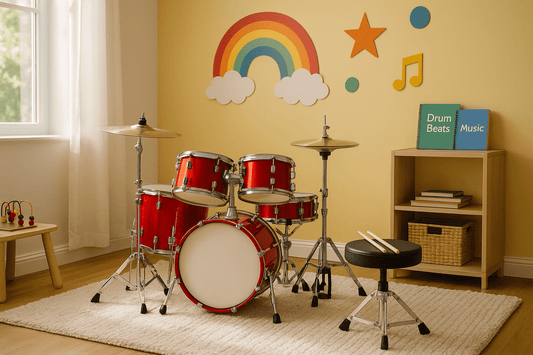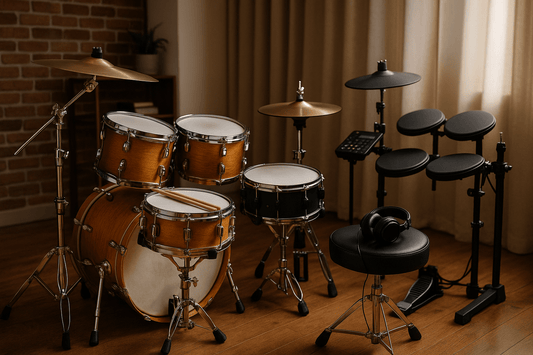Introduction
Choosing your child’s first drum kit is exciting—but it can also be a little confusing. Should you go for the classic thump and crash of an acoustic drum set, or the modern, tech-friendly option of an electric one? As a parent, you want something that fits your child’s energy, your space, and your family’s routine.
With music education making a big comeback and rhythmic learning linked to emotional and cognitive development, more Australian families are investing in beginner-friendly kits. But before you jump into the world of crash cymbals and drum pads, let’s break down what matters most—starting with the pros and cons of electric vs acoustic drum kits for kids.
In this guide, we’ll walk you through everything you need to know so you can confidently choose a kit that matches your child’s age, space, noise level, and learning style. We’ll also point you toward high-quality options from our collection of kids drum kits that offer the best value and performance.
What’s the Difference Between Electric and Acoustic Drum Kits?
Let’s start with the basics.
Acoustic Drum Kits
These are the traditional drum sets you picture in rock bands or school concerts. They include:
-
Wooden or metal shells
-
Real drumheads
-
Cymbals (hi-hat, crash, ride)
-
Pedals and stands
How they work: You strike the drum with sticks, and the sound is produced naturally—no electricity or amplification needed.
Electric Drum Kits
These are modern setups with:
-
Rubber or mesh drum pads
-
Digital sound modules
-
Headphone and speaker output
-
Built-in rhythms, lessons, or app compatibility
How they work: When your child hits the pad, it triggers a sound sample through the module. The volume can be adjusted, or muted completely with headphones.
Key Differences at a Glance
| Feature | 🥁 Acoustic Drum Kit | 🎧 Electric Drum Kit |
|---|---|---|
| Sound | 🎵 Loud, natural vibrations | 🔇 Adjustable volume, silent with headphones |
| Space | 🏠 Requires more room | 📦 Compact and often foldable |
| Learning Tools | ❌ None included | 📱 Built-in lessons, play-along tracks, app support |
| Feel | 👐 Authentic, real drumstick rebound | 🤖 Slightly synthetic, depends on pad quality |
| Setup & Maintenance | 🔧 Needs tuning and part replacements | ⚡ Plug-and-play, minimal upkeep |
| Best For | 🎸 Traditional learners, school bands | 🎮 Modern learners, apartment-friendly households |
Pros of Electric Drum Kits for Kids
Electric drum kits are booming in popularity among parents—and for good reason. Here’s why they might be the perfect pick for your little drummer.
1. Volume Control = Happy Neighbors
The biggest win? Headphone compatibility. Your child can rock out to their heart’s content while the house stays quiet. This is ideal for:
-
Apartment living
-
Sibling nap times
-
Early morning or after-hours practice
2. Space-Saving Design
Electric kits tend to be more compact. Some models even fold or collapse for easy storage. Perfect for smaller bedrooms or shared spaces.
3. Built-In Learning Tools
Most electric kits include:
-
Play-along songs
-
Metronomes
-
Practice modes
-
Bluetooth or app connectivity
These features make learning fun and structured, especially for kids learning without a teacher.
4. Digital Flexibility
Electric kits often come with different drum sound profiles—rock, jazz, hip-hop—so your child can experiment with different genres without needing new gear.
5. Easy Maintenance
No tuning, no replacing drumheads, and fewer worries about wear and tear.
Cons of Electric Drum Kits for Kids
While electric kits bring a lot of convenience, they’re not always the perfect fit for every family. Here’s where they might fall short:
1. Less Realistic Rebound
Even with mesh pads, electric kits don’t always replicate the exact feel of an acoustic drum. The natural vibration and stick response may be different, which could slightly affect technique development—especially for older kids considering lessons or performance.
2. More Expensive Upfront
While they save on accessories and noise control, electric kits often come with a higher price tag—especially for quality sets. Entry-level acoustic kits can start cheaper.
3. Technology Can Be a Hurdle
For younger kids (ages 3–5), navigating the tech (sound modules, buttons, cables) might feel complicated. They’ll likely need adult setup and guidance, at least at the beginning.
4. Requires Power & Cables
Electric kits need to be plugged in. This limits where you can place them unless you have a nearby outlet. Also, exposed cables can be a trip hazard for toddlers if not managed well.
Pros of Acoustic Drum Kits for Kids
If you want your child to get a traditional drumming experience, an acoustic kit is a powerful place to start.
1. Real Sound and Feel
There’s no substitute for the sound of a real snare crack or cymbal crash. For older kids especially, authentic feedback helps them refine control, timing, and coordination faster.
2. Builds Foundational Technique
Because acoustic drums respond more dynamically to playing strength and angle, kids naturally build better stick control, posture, and muscle memory from the start.
3. Great for Formal Lessons or School Band
Many schools and teachers recommend starting with an acoustic set. It aligns with the curriculum and gets your child used to live performance expectations.
4. Often Lower Starting Cost
Beginner acoustic kits—like small 3- or 4-piece sets—are usually more affordable than equivalent electric kits, making them ideal for testing your child’s interest before investing further.
Cons of Acoustic Drum Kits for Kids
Every parent who's bought an acoustic drum set has had this moment: "It's how loud?!" Here’s what to know before going acoustic:
1. Noise, Noise, Noise
There’s no volume knob. Your child will be making real drum sounds—which means practicing at odd hours might not be practical. Not ideal for apartments, townhouses, or families with light sleepers.
2. Takes Up More Space
Even a small acoustic kit needs room to breathe—plus space for stools, sticks, and accessories. They’re also harder to store or move when not in use.
3. More Maintenance
Drums need tuning, cymbals wear down, and sticks break. Expect to spend a little time and effort maintaining the set (though it can be a great learning opportunity for your child).
4. May Intimidate Younger Kids
A full-size or even junior acoustic kit can feel overwhelming to a 4- or 5-year-old. Without a teacher’s guidance, they might lose interest.
Ideal Age and Skill Levels for Each Type
Your child’s age and experience level should guide your decision more than brand names or fancy features. Here’s a quick breakdown:
| Age Group | Best Option |
|---|---|
| 3–5 years | Electric kits with soft pads or toy-style acoustic drums |
| 5–7 years | Entry-level acoustic kits or compact electric sets |
| 7–10 years | Mesh-head electric kits with lessons or 5-piece acoustic |
| 10+ years | Full beginner acoustic or mid-range electronic kits |
If you’re unsure where to start, the curated selection on Tempo Gear offers high-quality electric and acoustic kits tailored for each stage.
Safety, Space & Parent-Friendliness
As parents, we don’t just care about beats—we care about bedtime, mess, and not tripping over drum pedals. Here’s how each type scores:
Noise
-
Electric: Clear winner here—plug in headphones, and your child can play quietly all day.
-
Acoustic: Loud and proud. Great if you have tolerant neighbors or a detached music room.
Safety
-
Electric: Softer pads = less risk of stick bounce or finger pinching. Watch cords.
-
Acoustic: More hardware, sharper edges on cymbals. Choose rounded designs and padded sticks for young kids.
Maintenance
-
Electric: Low upkeep. Occasional dusting and software updates.
-
Acoustic: Needs tuning, stick replacement, and regular inspections.
Storage & Portability
-
Electric: Compact and easy to fold or move.
-
Acoustic: Bulky, harder to move or break down without tools.
Price & Value: Which Kit Offers More?
Let’s talk numbers. While both electric and acoustic kits offer value in different ways, your decision will likely be shaped by your budget and your child’s commitment level.
💰 Acoustic Kits: Lower Entry Point
-
Basic starter kits (3–4 pieces) can start around $100–$200 AUD
-
Often include a stool, sticks, and cymbals
-
Replacement parts (sticks, heads) are cheap and easy to find
-
Great for testing interest without a big upfront investment
⚡ Electric Kits: Higher Upfront, More Features
-
Entry-level kits start around $250–$400 AUD, with premium models exceeding $800+
-
May include headphones, cables, built-in apps, or lesson modes
-
Saves money on noise solutions (soundproofing, mutes, etc.)
-
Some models, like the MX510 Electric Drum Kit, include everything needed for practice right out of the box
🎯 Long-Term Value
-
Electric kits often last longer if upgraded digitally (firmware, apps)
-
Acoustic kits grow with your child and can be expanded piece by piece
💡 Pro Tip: If you’re unsure about long-term use, start with a high-quality budget kit and upgrade once your child shows consistent interest.
How to Make the Right Choice for Your Child
Here’s a simple checklist to help you decide between electric and acoustic:
✅ Ask Yourself:
-
Where will it go? (Small room? Apartment? Garage?)
-
How sensitive are the neighbors?
-
Will they use apps or take lessons?
-
Are they self-motivated or need built-in support?
-
Do you plan to expand the kit later?
🎯 Choose Electric If:
-
Noise is a concern
-
You need to save space
-
Your child enjoys tech-based learning
-
You want built-in practice tools
🥁 Choose Acoustic If:
-
Your child is taking formal lessons or joining a band
-
You have a separate music/playroom
-
You want the most realistic sound and feel
-
Budget is tight
💬 Remember: There’s no one-size-fits-all drum kit. The best choice is the one that helps your child fall in love with music and feel confident every time they play.
Final Thoughts: Follow the Beat That Fits Your Family
Whether you choose a high-tech electric set or a traditional acoustic drum kit, you’re doing something amazing: giving your child a creative outlet that builds confidence, rhythm, coordination, and focus.
Electric drum kits like the MX510 Electric Drum Kit offer modern convenience and quiet learning, while acoustic sets bring old-school realism and pure, resonant energy. What matters most is that the kit fits your space, your child’s learning style, and your family’s rhythm.
Let your child explore, experiment, and express themselves. You never know—you might just be raising the next Ringo Starr or Questlove.
FAQs
1. Is an electric drum kit good for beginners?
Yes! Especially for kids, electric kits provide quiet play, digital learning tools, and adjustable volume—making them perfect for apartments and shared households.
2. Are acoustic drums too loud for kids?
They can be. Acoustic kits are loud by nature, which can be an issue for small homes or neighbors. You can reduce volume slightly with practice pads or drum mutes, but they’ll never be fully quiet.
3. What’s the best drum kit for apartments?
An electric drum kit is your best bet. Look for one with mesh pads, headphones, and a compact rack system for tight spaces.
4. Can a child learn drums without formal lessons?
Absolutely. Many electric kits offer built-in practice tracks, metronomes, and app integration. With parental support and online resources, self-learning is very possible—especially for ages 6+.
5. How long will a kids drum kit last?
With proper care:
-
Electric kits can last 3–5+ years, longer with digital upgrades
-
Acoustic kits last indefinitely if maintained and tuned Look for durable frames, replaceable pads or heads, and upgrade options for long-term use.




